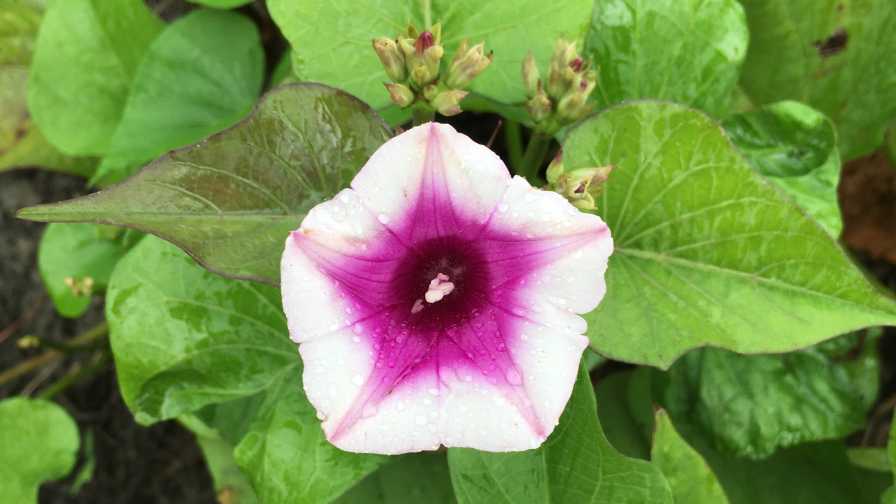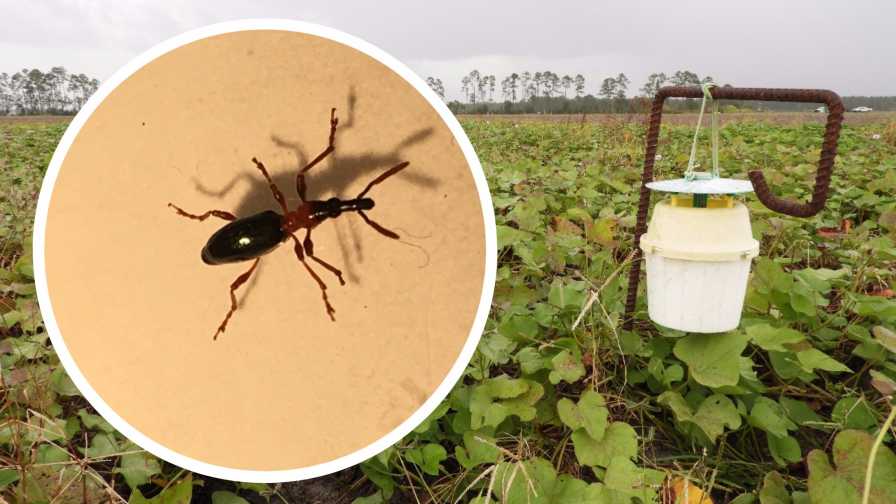Florida Growers and Researchers Unearthing Sweet Potato Potential

Sweet potato production has been blossoming in the U.S. over the last decade. More Florida farmers are considering this hot crop for the summer.
Photo by Bonnie C. Wells
Sweet potato production is a sure sign of summer in the Southeast U.S. And this is becoming the case for more growers every year. According to USDA, production of sweet potatoes in the U.S. has increased substantially over the past decade. In 2015, domestic production figures reached record levels at 3.1 billion pounds.
Needless to say, the sweet potato isn’t just for the holiday plate any more, and if you have ordered a side of fries or chips recently at a restaurant, your server most likely asked you, “Will that be regular or sweet potato?” That’s because food trends have been steadily shifting toward the consumption of healthier, more colorful foods such as the sweet potato; and growers can certainly use that to their marketing advantage.
The viny tropical vegetable is a distant relative of the white potato that thrives in the heat of the long summer days. It is a versatile crop harvested, not only for its highly nutritious tubers, but also for its leaves, both for human and livestock consumption. It also is produced as a bioenergy crop.
A Fit for Florida?
According to the latest estimates, Florida produces nearly 6,000 acres of sweet potatoes on 40 farms with the majority of the production in Miami-Dade and Suwannee counties. But growers in other parts of the state, such as in Tri-County Agricultural Area (St. Johns, Putnam, and Flagler counties), have been looking for alternative crops like sweet potato to diversify their farming operations and enhance sustainability.
The crop isn’t new to the area but, until recently, hasn’t been grown commercially there for more than 20 years. In fact, sweet potatoes were one of the reasons why Hastings, located in the heart of St. Johns County, earned the reputation as the “Potato Capital of Florida.” In the early 1900s, the Hastings area shipped out 43,000 bushels of white potatoes and 23,000 bushels of sweet potatoes every year via railroad to U.S. northern markets.
The Hastings area still leads the state in production of white potatoes, with production occurring from January to June. Sweet potatoes are planted in the spring and early summer, after the growing season for white potatoes, so they can fit nicely into the traditional production systems. And, if growers can take advantage of Florida’s climate and plant sweet potatoes earlier than in other competing states, they might hit a market window advantage and get higher prices.
However, Florida farmers presently rely on getting slips, or young plants, commercially produced for planting from other Southeast states that aren’t available for Florida’s early planting season. Other limits to sweet production in the state are the sweet potato weevil and other insect pests that nearly devastated the industry in the 1980s. Also, because the crop hasn’t been grown in the area for some time, research-based recommendations for variety selections and nutrient management are unknown for the Hastings area soil type.

Traps in this field of sweet potatoes at the UF/IFAS Hastings Agricultural Extension Center’s Cowpen Branch demonstration farm are helping researchers monitor for sweet potato weevil activity.
Photos by Bonnie C. Wells
Despite the challenges, with help from UF/IFAS Extension specialists and agents, growers are starting to get some of the answers needed to overcome production challenges. Research and demonstration trials evaluating suitable varieties and nutrient regimes for crop efficiencies at the UF/IFAS Hastings Agriculture Extension Center’s Cowpen Branch farm are now going into their second season.

‘Palmetto’
Photo by Bonnie C. Wells
Taking the Case to Trial
So far, field trials have evaluated yield and optimal nitrogen rate for four varieties: the white-fleshed, purplish-skinned ‘Boniato,’ the orange-fleshed, red-skinned ‘Burgundy,’ the purple-fleshed, red-skinned, ‘Palmetto,’ and the orange-fleshed, red-skinned standard for production in the U.S., ‘Covington.’
UF/IFAS researchers also have been monitoring populations of the sweet potato weevil, as well as working to perfect the art of slip production that could become a supply for the local growers.
Results show that ‘Boniato’ was the best yielding variety, followed by ‘Burgundy,’ ‘Palmetto,’ and ‘Covington.’ Although ‘Boniato’ and ‘Burgundy’ had greater yields, ‘Palmetto’ may demand a better price with a promising market potential for Florida because of its high content of purple anthocyanin, an antioxidant that not only makes this sweet potato a superfood, but gives it an alluring purple color.
Among the nitrogen rates tested, 90 lbs. per acre had the best yield and nitrogen-use efficiency, and may be considered an appropriate nitrogen application rate for sweet potato production in the area. So far, sweet potato weevil populations have been very low, but will continue to be monitored in the area.










